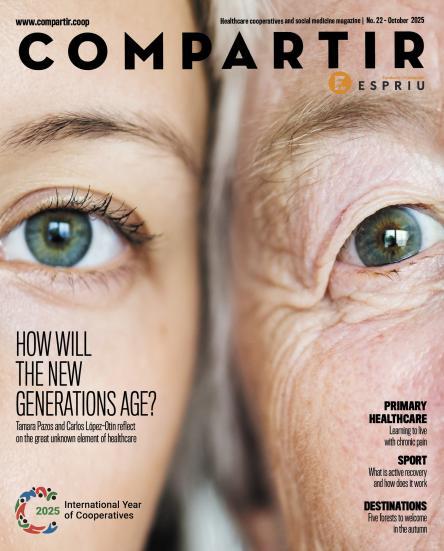
The treatment involves listening, availability and above all, continuity
Mental health is essential and although there is a traditionally separate view of the body and the mind, both are completely intertwined. This is the statement made by José Abad Almendáriz, the National Psychiatry Coordinator at ASISA, who comments that “if the mind is working badly, the physical part is as well; and to the contrary, if the physical area fails, it can have consequences in the mental part”.
The Covid-19 crisis caused a great shake-up for the population’s mental health. “Illnesses that any of us could suffer from such as anguish or stress have increased with the arrival of an unusual and unpredictable element that diminished society’s safety,” Abad comments. The basis of pre-pandemic mental illnesses has little to do with the current situation in Spain regarding these disorders. “When faced with a crisis such as the one we experienced, fear levels rise a great deal and this fear causes insecurities that derive in adaptive mental disorders such as anxiety or depression.” In spite of this, the psychiatric specialist trusts the innate ability of human beings and society in general, to overcome the obstacles and come through. Although he qualifies this by stating that in the more serious disorders such as psychosis or schizophrenia specialised treatment is always required.
Doctor José Abad Almendáriz assures that in the mental health field, diagnosis is “relatively more simple” than in other medical disciplines and that the most important point is, without any doubt, “continuity.” He criticises that, for example, a patient with schizophrenia may not be attended until six months after a consultation or that a young person with a suicide attempt may not be attended in four months. “Once the diagnosis has been made, the most important element is the treatment and this irremediably involves care, listening, availability and continuity,” he explains.
The future of mental health
Doctor Abad is clear that the current mental health model is “insufficient.” And, for the psychiatrist, its future involves “getting back to the dialogue between doctors and patients.” Medicine, for him, must be human by definition and if there is a debate going on about the need to humanise medicine it means that “we are doing something wrong and we are leaving it in the hands of algorithms, computers and technology.” Without any doubt, listening to patients is essential, and even more so in mental health consulting rooms. “A patient comes into the surgery looking for one thing: for you to look at them, touch them, listen to them… and if a person with anxiety or depression does not find a specialist who listens to them, they will not be able to get better.” In short, “we are not doing the most basic things.” This more humanist view also demands greater availability of specialists and a fight against long waiting lists. Another key aspect, in this context, is finding the balance between the new technologies and personal care. At present, virtually all psychologists and psychiatrists are working with video calls, chat and other technological instruments on a daily basis. But the National Psychiatry Coordinator at ASISA warns that all this technology must be used to “complement the continuous care of a patient and not turn the screen into the only vehicle for communication and care”.
Identifying the warning signs
At present, the most regular symptoms that are being seen in consulting rooms are those related to anxiety and depression: today’s two great mental disorders. These involve fear, impaired emotional states of mind, extreme behaviour, people putting themselves in risky situations, etc. In spite of this, according to Abad, one of human beings’ most basic defence mechanisms is negation. And this can be dangerous in the area of mental health. For the doctor, the positive part is that people usually interact in society: “for this reason, if a patient does not realise that they need help, someone from their family or workplace will certainly help to detect any change and raise the alarm.” Accordingly, it is important to stress that specialists talk about a pathology after some time has passed, for example, a few weeks in a different state of mind or with a great deal of anxiety. “Some time must go by because there might be certain moments of sadness, anxiety or stress and this is not a bad thing,” he considers. In fact, he warns about the excessive “psychiatrisation of daily life;” that is to say, “everything is taken to the psychologist and people look for reasons for every feeling.” Linked to this, José Abad believes that it is essential “to learn that life leaves nobody unscathed and that problems and obstacles can arise that have to be overcome.” This fight against adversity is natural and according to him, it should be one of the central points in young people’s education. “It is a social topic and it is effective prevention. The idea is to educate strong children, to stimulate them, console them, love them and help them to live life without fear,” he believes.
Young people: what are the risk factors?
The data is worrying: a large majority of mental disorders start during adolescence. Abad assures that “all the serious mental disorders such as schizophrenia appear from the age of 14 or 15 years onwards, which is when the first signs appear.” He adds that, at this time, it is essential for specialists to be very careful with the diagnosis because “adolescence is such an ebullient and turbulent state that the risk is run of stigmatising a young person at a crucial moment in their life.” It is probable, according to different cases, that a specific diagnosis is not reached immediately, but a treatment might be started, setting forth the idea of the disorder as a momentary crisis and smoothing down the situation. Regarding the risk factors, there are three variables, the doctor indicates. Genetics, the social factor and the individuals themselves. “All of these have an effect: ranging from genetic baggage, being born in the heart of a de-structured family or one with deficiencies, to the narcissistic ideals of society that young people see every day on social media,” he recounts. Particularly, great advances are being made in the field of genetics and in spite of the fact that the chromosomes are in command, “there are genes that are not enough to produce a mental illness.” For Abad, in order for these genes to express themselves, certain determined social behaviours must also occur. That is to say, that “genes are not powerful enough to mark you for life”.
Another of the great problems related with the worrying mental health amongst young people is the consequence of the abusive use of social media. On many aspects, these can be extraordinary means, but they also usually promote “supposedly ideal models for people that make others feel frustrated.” For the National Psychiatry Coordinator at ASISA, “there is an evident social problem” and he illustrates this with other professional colleagues, plastic surgeons, who are increasingly receiving young people in their consulting rooms who want to operate their faces to look like someone they have seen on the Internet, “and they go directly with the photo of this person.” For Abad, situations like these are causing “the cover up of a social problem and a serious personality disorder.” Finally, another curse that worsens young people’s health is the taking, sporadic or not, of drugs or other toxic substances. “Teenagers can have a fragile personality and sporadically starting to smoke joints and taking cannabis can shake the foundations of their lives.” And he also recalls the danger of always living in the present. “Young people do not think about the long-term consequences that this joint is going to have,” he points out. Society in general and teenagers in particular, “do not think about yesterday and furthermore, the future does not exist” and for the specialist this involves a great risk.
The burden of stigmatisation of the mental illness
A serious and/or chronic illness means a “shock for anyone” because it affects the most essential part of the person and for this reason it is normal for “their personality to become shaken and to suffer from anxiety,” Abad explains. Therefore, it is common for recently-diagnosed patients of cancer or other serious diseases to suffer from low emotional moods and moments of depression. “In this type of diagnosis, multidisciplinary protocols are immediately activated,” he adds. The great problem arises when discrimination is shown towards mental disorders, particularly the most serious ones such as schizophrenia. Abad illustrates this: “in the beginning euphemisms are usually used, saying that this person has problems; later on, that the person is more depressed due to certain circumstances. But, the moment it is stated that this person is suffering from depression, people do not look at them in the same way. And in the more serious disorders such as psychotic episodes, there is even more stigmatisation.” Therefore, the expert proposes “encouraging these patients to contact professionals as soon as possible.” The stigmatisation ends up deriving into social problems, “and even within the family itself, the members of which in some cases, can feel shame or guilt.” And the in reality, what people with mental health problems need most is unconditional support and backup from doctors, specialists and today, “from associations, support groups…” Fortunately, José Abad concludes, mental illness is becoming more visible all the time; as is his profession, which has gone from “being an undervalued discipline to turning into a highly demanded speciality, more so after the pandemic”.
 José Abad Almendáriz
José Abad Almendáriz
National Psychiatry Coordinator at ASISA.
Adviser of Lavinia Sociedad Cooperativa.




